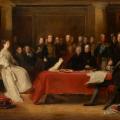Queen Victoria is Born in 1819
On May 24, 1819, Alexandrina Victoria was born in the dining room of Kensington Palace amid the “baby race” of the potential succession crisis looming of the late 1810s, delivered by the same woman who also delivered her first cousin and future husband Albert. She grew up in Kensington Palace as well, provided with many talented teachers and tutors but restricted under the “Kensington System.” She resented the restrictive nature of the system’s rules imposed on her by her mother and Sir John Conroy, whom her mother depended on after her husband and Victoria’s father died. Despite this, she was able to tour the country and was seen as a new hope for the country as she was not associated with the negative parts of the dynasty. In the early morning of 20 June 1837, she learned she was then Queen Victoria, as her uncle, the king, had died.
Over the course of Victoria’s reign, the area around Kensington Palace became more urban as cohesive building projects started in the mid-1800s. The Great Exhibition nearby helped draw more people to the area. Notably, buildings were for upper-class residents and artists, as luxury buildings with modern amenities and artistic communities started to appear. The Royal Borough of Kensington and Chelsea is a royal borough due to their combined connections with royalty. In fact, Victoria wished for Kensington to have the title of a royal borough, which her son Edward VII granted.
Queen Victoria’s legacy reaches far and impacts most of the world. Known as the “Grandmother of Europe” for her many descendants and “Grandmother of the Empire” for her appearance as a ruler, many things have been attributed to her or her family: hemophilia, white wedding dresses, and Christmas trees are just a few examples. Her life story, particularly her marriage to her cousin Albert, has been romanticized many times in film, thanks to her prolific diaries and outward appearance as a happy family, which was true in some respects. However, it has been noted that she was a poor mother, particularly to her son Bertie, or Edward VII. She blamed him for Albert’s death as she wore black for the rest of her life.
Ultimately, however, her life and legacy were immensely important to world history, and that all started at Kensington Palace.

Wilkie, David. Victoria, Duchess of Kent, (1786-1861) with Princess Victoria, (1819-1901). 1821. Royal Collection. https://www.rct.uk/collection/407169/victoria-duchess-of-kent-1786-1861-with-princess-victoria-1819-1901. Accessed 18 April 2023.
Wilkie, David. The First Council of Queen Victoria. 1838. Royal Collection. https://www.rct.uk/collection/404710/the-first-council-of-queen-victoria. Accessed 18 April 2023.
“Growth of a Victorian Suburb.” The Royal Borough of Kensington and Chelsea, https://www.rbkc.gov.uk/vmhistory/general/vm_hs_p10.asp. Accessed 18 April 2023.
“Metropolitan Boroughs.” The Royal Borough of Kensington and Chelsea, https://www.rbkc.gov.uk/vmdemocracy/general/vm_ld_p11.asp. Accessed 18 April 2023.
“Queen Victoria.” Historic Royal Palaces, https://www.hrp.org.uk/kensington-palace/history-and-stories/queen-victoria/. Accessed 18 April 2023.
Ridley, Jane. “Queen Victoria: The Real Story of Her 'Domestic Bliss'.” BBC News, BBC, 1 Jan. 2013, https://www.bbc.com/news/magazine-20782442. Accessed 18 April 2023.

